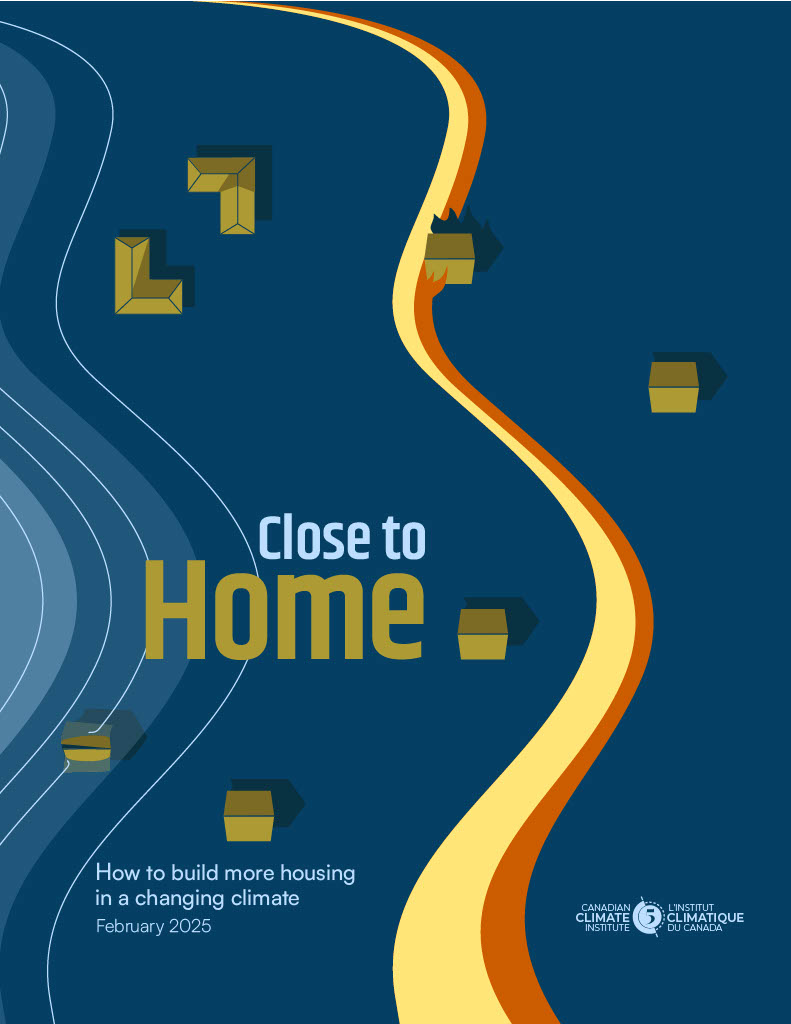Communities Need to Consider Climate Risks When Planning New Homes

Governments must adopt policies to ensure new homes are built away from floods and wildfires


6 February 2025
Research by the Canadian Climate Institute and SSG shows local governments can decrease costly damage to new homes by incorporating climate risk analysis into planning decisions.
As governments across Canada work to build more housing and address the housing affordability crisis, they risk leaving hundreds of thousands of new homes vulnerable to the threat of wildfires and floods. This troubling reality is highlighted by a new study released by the Canadian Climate Institute and supported by analysis by SSG.
In fact, failure to consider climate risks could cost Canadians up to $3 billion annually in damages from floods and wildfires, explains the Institute’s report, Close to Home: How to build more housing in a changing climate. However, all levels of government can work together to prevent these damages through policies that steer housing and infrastructure development to low-hazard areas and away from high-hazard ones.
540k
new homes slated to be built in flood zones if policy changes are not made
~80%
reduction in flood risk if planned location of 3% new homes are shifted to be built away from hazardous zones
The scale of the problem and the solution
According to Canada Mortgage and Housing Corporation, 5.8 million new homes must be built by 2030 to meet Canada’s housing affordability goals. Unless changes to how new developments are approved take place, 540,000 new homes could be in flood zones and 220,000 would be exposed to high wildfire hazards by 2030, according to modelling conducted by SSG for the report. Using data from wildfire risk models developed by the Cooperators and flood risk models from Fathom Global, SSG modelled the potential financial costs of floods and wildfires with ScenaAdaptation, a scenario model we designed to help communities prepare for extreme weather and other hazards related to global warming.
At the same time, SSG’s modelling shows that even a small shift in development away from high-risk flood areas can have a significant impact. Redirecting just 3% of homes targeted for construction by 2030 away from these hazardous zones could reduce Canada’s flood risk by nearly 80%. It’s a move that would benefit all Canadians, not just those living in high-hazard areas. When disasters happen, everyone is on the hook for higher insurance premiums and tax-funded disaster recovery efforts.
How municipalities can protect their communities
Close to Home calls for policy shifts at provincial and federal levels. Municipalities can also play an important role by integrating climate risk into land-use planning and restricting development in hazard-prone areas. Such measures might seem like no-brainers, but the reality is not so simple.
In the face of pressure from developers, high demand for housing, and a lack of up-to-date data on climate risks, it can be easy for municipal governments to greenlight development in risky zones. We see our municipal clients struggle with such pressures everyday in the face of an urgent housing affordability crisis. But, as Close to Home puts it, the long term reality is simple: “the most affordable home is the one that doesn’t have to be rebuilt after a disaster.”
The Town of Whitby offers an example of proactive municipal action. Our modelling for the Whitby Climate Emergency Response Plan revealed that building in flood-prone areas could result in up to $17 billion in damages. In response, the town shifted future development out of these areas. All municipalities can pull such levers while broader provincial and national policies are still in the pipeline.
Municipalities can play an important role by integrating climate risk into land-use planning and restricting development in hazard-prone areas.
Preventing development in hazard zones ensures today’s housing projects won’t become tomorrow’s climate liabilities.
Leveraging data and mandating hazard disclosure
A significant barrier identified in the report is outdated or incomplete flood and wildfire hazard maps, which leave developers, municipalities, and homeowners with insufficient information about climate risks. Without mandatory hazard disclosure in real estate transactions, buyers and renters often remain unaware of the risks they are assuming.
While federal, provincial, and territorial governments should provide updated maps, municipalities can work with firms that specialize in risk mapping in the interim to make informed land-use decisions. Moreover, municipalities can take steps to require mandatory disclosure of flood and wildfire risks in all housing transactions, ensuring that homebuyers and renters are fully aware of the climate risks associated with their properties.
Taking action today to protect tomorrow
We hope the analysis in Closer to Home provides a clear call to action for policymakers at all levels. The evidence is clear: preventing development in hazard zones ensures today’s housing projects won’t become tomorrow’s climate liabilities.
Report
Close to Home: How to build more housing in a changing climate
This report features first-of-its-kind nationwide analysis on new housing slated for development to meet Canada’s affordable housing targets.
It shows new developments will be affected by significant financial risks related to climate change-fuelled disasters unless governments at all levels incorporate climate risks into decision-making about where new developments are built.
Wildfire risk models used in the report were developed by Co-operators; flood risk modelling was done through Fathom Global and SSG (Sustainability Solutions Group) analyzed future housing risk. Information design was provided by Voilà.
You can download the full report here
Contributors
SSG
Fathom Global
Cooperators
Voilà
Year
2025
Publisher
Canadian Climate Institute
Contact Us
Have questions about our services or want to know more about how we can help you?





